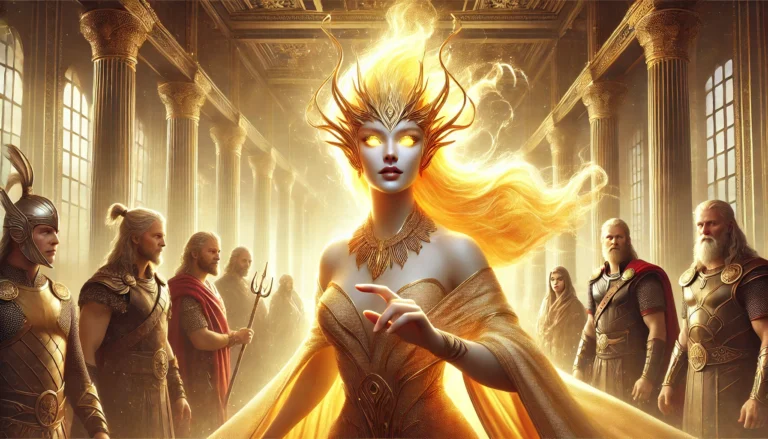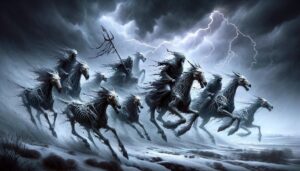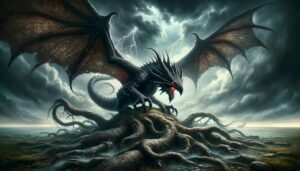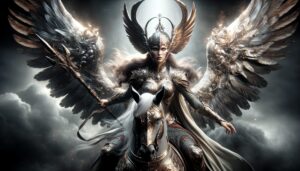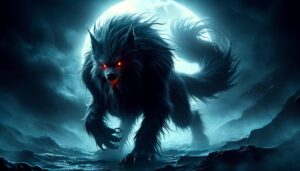Table of Contents
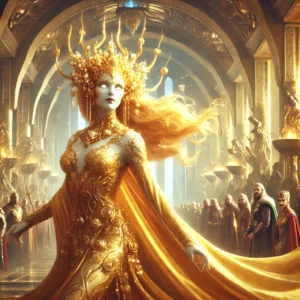
Gullveig, a prominent figure in Norse mythology, is a mysterious and complex character whose story intricately weaves through the themes of greed, conflict, and the cyclical nature of life and death. Moreover, her tale is one of transformation, resilience, and the potent power of desire, influencing the ancient narratives of the gods and the world they inhabit.
Origins
Gullveig originates from the enigmatic realm of the Vanir, one of the two main groups of deities in Norse mythology, alongside the Aesir. The Vanir primarily associate with fertility, prosperity, and natural forces, whereas the Aesir link with war, governance, and order. Many consider Gullveig a Vanir goddess, although some interpretations suggest she might be a sorceress or a giantess.
The most detailed account of Gullveig appears in the Poetic Edda, a collection of Old Norse poems compiled in the 13th century. The poem “Völuspá” introduces her, marking the beginning of the first war between the Aesir and the Vanir, known as the Aesir-Vanir War. This conflict significantly impacts the cosmic order, reflecting the inherent tension between different aspects of life and the gods’ complex relationships.
Appearance
Descriptions of Gullveig’s appearance are sparse and often symbolic. Typically, she is depicted as a figure of striking beauty, embodying the allure of gold and wealth. Moreover, her name itself translates to “gold-drink” or “gold-power,” indicating her deep connection with wealth and its seductive power. Additionally, some interpretations suggest she might have a radiant, golden appearance, reflecting her association with precious metals and the greed they inspire.
Abilities
Gullveig is renowned for her extraordinary abilities, particularly in magic and sorcery. In Norse mythology, she is often linked with seidr, a form of magic associated with prophecy, shapeshifting, and controlling fate. Her proficiency in seidr makes her a powerful and influential figure, capable of manipulating events and influencing the actions of gods and mortals alike.
Weakness
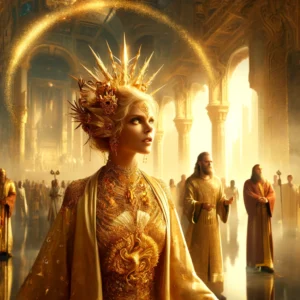
Despite her formidable powers, Gullveig has a significant vulnerability: her connection to gold and material wealth. This attachment to gold symbolizes greed and the destructive nature of avarice. It is this greed that ultimately leads to her downfall and subsequent rebirth, illustrating the cyclical nature of life, death, and renewal in Norse mythology.
Behavior with Humans
Gullveig’s interactions with humans are less documented than her dealings with the gods. Her association with seidr suggests she taught or practiced magic among mortals. In Norse culture, women, known as völvas, often practiced seidr and served as seers and healers in their communities. Gullveig’s influence in this regard underscores the significance of magic and prophecy in human affairs and the interplay between divine and mortal realms.
Symbols
Gullveig is primarily symbolized by gold and fire, reflecting her dual nature as both a source of wealth and destruction. Gold represents her allure and the greed she incites, while fire symbolizes her resilience and transformative power. These symbols capture the essence of her character and her impact on the mythological landscape.
Related Myths and Stories
The most significant myth involving Gullveig is her role in the Aesir-Vanir War. According to “Völuspá,” Gullveig arrives in Asgard, the realm of the Aesir, where her obsession with gold incites the gods’ wrath. They attempt to kill her by burning her three times, but each time she is reborn from the ashes, unscathed. This act of violence and resurrection symbolizes the indomitable nature of greed and desire, as well as the inevitability of conflict.
Her repeated resurrections provoke the Aesir to declare war on the Vanir, leading to a prolonged and devastating conflict. Eventually, the two groups of gods reach a truce and establish a new order, exchanging hostages and merging their pantheons. This war and its resolution underscore the themes of transformation, reconciliation, and the cyclical nature of time in Norse mythology.
Other Creatures
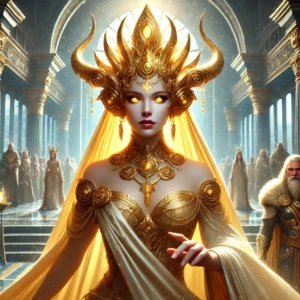
In Norse mythology, other figures share similarities with Gullveig, particularly in their association with magic and transformation. One such figure is Freyja, the Vanir goddess of love, beauty, and fertility, who is also a practitioner of seidr. Freyja’s connection to gold and her role as a powerful sorceress parallel Gullveig’s attributes, although Freyja is portrayed in a more positive light.
Another comparable figure is Loki, the trickster god known for his shape-shifting abilities and penchant for causing chaos. Like Gullveig, Loki’s actions often lead to significant conflicts and transformations within the mythological narrative. His unpredictable nature and mastery of magic align him with the themes of change and duality embodied by Gullveig.
Narrative Style Exploration
Imagine the scene in Asgard when Gullveig first arrived. Her presence was like a golden storm, captivating the Aesir with her radiant beauty and the promise of wealth. Yet, beneath her alluring exterior lay a tempest of desire and greed, a force that the gods could neither ignore nor control.
As she moved through the halls of Asgard, her eyes gleaming with an otherworldly light, the Aesir grew uneasy. They sensed the disruption she brought, a shift in the balance of power that threatened their dominion. Odin, the Allfather, watched her with a mix of fascination and suspicion, aware that her arrival marked the beginning of something profound and irrevocable.
In a desperate bid to quell the unrest she incited, the Aesir attempted to destroy her. They bound her to a pyre and set it ablaze, believing that fire would cleanse their realm of her influence. Yet, as the flames consumed her, Gullveig’s laughter echoed through the inferno. Three times they burned her, and three times she rose from the ashes, reborn and unbroken.
Her defiance enraged the Aesir, sparking the war with the Vanir that would reshape the cosmos. The battle raged across the realms, gods clashing with gods in a cataclysm of magic and might. Eventually, peace was forged from the fires of conflict, a tenuous alliance that merged the two pantheons and reshaped the divine order.
In the aftermath, Gullveig’s legacy endured, a testament to the enduring power of desire and the transformative force of conflict. Her story serves as a reminder that even in the face of destruction, renewal is always possible, and the cycle of life and death continues unbroken.
Conclusion
Gullveig’s tale is a rich tapestry of transformation, conflict, and the potent allure of desire. Her character embodies the duality of creation and destruction, reflecting the complex interplay of forces that shape the Norse mythological universe. Through her story, we glimpse the profound truths of resilience and the inevitable cycles of life, death, and rebirth that define existence.
Her enigmatic presence and the enduring impact of her actions highlight the timeless themes of greed, power, and the quest for harmony amid chaos. In exploring Gullveig’s myth, we uncover a deeper understanding of the human condition and the eternal dance of the divine and mortal realms.
FAQ
What does Gullveig's name mean?
Her name translates to "gold-drink" or "gold-power," indicating her deep connection with wealth and its seductive power.
What is Gullveig's origin?
Gullveig originates from the Vanir, a group of deities associated with fertility, prosperity, and natural forces. Some interpretations suggest she might be a sorceress or a giantess.
How is Gullveig depicted?
Descriptions of Gullveig's appearance are sparse and often symbolic. Typically, she is depicted as a figure of striking beauty, embodying the allure of gold and wealth, with a possible radiant, golden appearance.
What abilities does Gullveig possess?
Gullveig is renowned for her extraordinary abilities in seidr, a form of magic associated with prophecy, shapeshifting, and controlling fate.
What is Gullveig's main weakness?
Her main weakness is her connection to gold and material wealth, symbolizing greed and the destructive nature of avarice.
What symbols represent Gullveig?
Gold and fire primarily symbolize Gullveig, reflecting her dual nature as a source of wealth and destruction, and her resilience and transformative power.
What is Gullveig's role in the Aesir-Vanir War?
Gullveig's arrival in Asgard and her obsession with gold incited the wrath of the Aesir. They attempted to kill her by burning her three times, but she was reborn each time, leading to the Aesir-Vanir War.
What are the main themes in Gullveig's story?
Her story encompasses themes of greed, transformation, resilience, and the cyclical nature of life and death, highlighting the complex interplay of forces in Norse mythology.
Are there other figures similar to Gullveig?
Other figures in Norse mythology with similar attributes include Freyja, the Vanir goddess of love and fertility, also a practitioner of seidr, and Loki, the trickster god known for shapeshifting and causing chaos.
